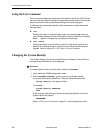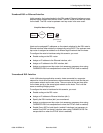
3. Configuring the DSL Router
3-6 November 2003 6300-A2-GB20-10
Operating mode (Standard or VNET) can be changed without reconfiguration of
the router. Static ARP entries can be configured, regardless of the current
operating mode. If static ARP entries are configured, they remain in the database
and can be displayed using the show arp CLI command.
Using CLI commands, you can:
Create up to 64 static ARP Table entries.
Display the ARP Table.
Delete ARP Table entries.
Display and delete automatically added ARP Table entries made by the DHCP
server and relay functions. Refer to Dynamic Host Configuration Protocol
(DHCP) Server on page 3-9.
Proxy ARP
The DSL router supports Proxy ARP. Proxy ARP responses are based on the
contents of the IP Routing Table for service domain traffic. The table must have
entry information that indicates what hosts can be reached on the Ethernet
interface, including hosts for which the router will not forward packets because of
IP filters. For additional information on filtering, see IP Protocol Type Filtering on
page 3-11.
Proxy ARP is not available on the DSL interface when the router is configured to
support RFC 1483 PDU routing. See Routed vs. Bridged PDUs on page 3-13 for
more information.
If an ARP request is received on one interface, and the requested IP address can
be reached on the other interface, the router responds with its own MAC address.
Using CLI commands, you can enable and disable Proxy ARP for each interface.
NOTES:
— When Basic NAT is enabled, the DSL interface (dsl1) must have Proxy
ARP enabled when the dsl1 interface address is part of the Basic NAT
global IP network address.
— Proxy ARP is not available on the DSL interface when PPPoE is enabled
for the ReachDSL Router.
— When IP Passthrough is enabled, the Ethernet interface (eth1) must have
Proxy ARP enabled.


















